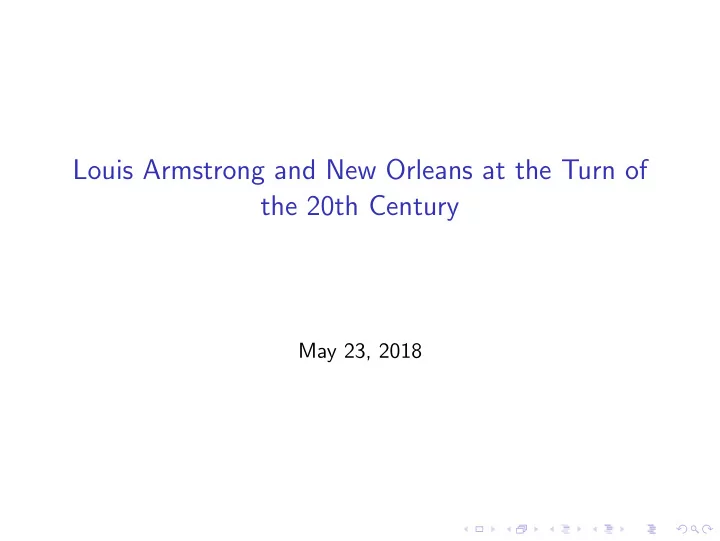

Louis Armstrong and New Orleans at the Turn of the 20th Century May 23, 2018
New Orleans ◮ Louisiana Purchase, 1803: influx of immigrants, slaves. French, Creole, African, Jews, Chinese. ◮ Balls ◮ 1840, 80 ballrooms in the city. (population 102,000) ◮ Quadroon balls – “dens of iniquity,” interracial sex ◮ “Strange sight: all the men white, all the women coloured or at least with African blood... Coloured women destined in a way by the law to concubinage. Incredible laxity of morals. Mothers, young girls, children at the ball. Yet another fatal consequence of slavery” (de Tocqueville) ◮ City has a reputation for a love for dancing and music. ◮ Placage
Buddy Bolden (1877 - 1931) ◮ Non-musical family. Begins cornet at 17. ◮ “king” bolden. Innovations: ◮ Personality, loudness, growls. ◮ Alcoholic, difficult personality. ◮ Mental health problems, 1907 committed by his mother to asylum. ◮ Funky Butt Hall (Louis Armstrong first hears Buddy Bolden here)
Joe ”King” Oliver ◮ Riverside Blues – King Oliver solo ◮ Chimes Blues - 1923 ◮ Dipper Mouth Blues – wah wah effect, Partial Transcription ◮ From New Orleans, eventually arrives in chicago, headlines his own group – calls Louis Armstrong to join. ◮ Crippling gum disease.
Louis Armstrong, 1900 - 1971 ◮ Early musical education in church ◮ Heterophony, rhythm, pitch bending ◮ Blues ◮ Parades ◮ Second line – on the way there vs. on the way home
Thomas Brothers, from Master of Modernism On the “fixed and variable” structure that Armstrong learned in church: even today it is rarely discussed in scholarly literature, and as a result the deep connections of Armstrong’s music to sub-Saharan Africa and to racially conditioned culture in the US have not been properly understood.
Grove music on Louis Armstrong’s solo on Chimes Blues ◮ Trancsription The two choruses of “Chimes Blues,” Armstrong’s first recorded solo, display a full, rich tone and contain the stylistic trademarks of a rip to a high note on a weak beat, the neighboring function of the raised second scale degree (d-sharp) and an ascending triplet followed by a descending arpeggio (ex.1). Consisting of repeated arpeggios that suggest clarinet passage work (Harker, 2003, 143), the solo’s melodic redundancy is relieved harmonically and rhythmically by the passing diminished chord (f-sharp–a–c) and metric displacement (quarter-note triplets across the bar line).
Blues ◮ Somewhat anachronistic, but the form is there: ◮ Sonny Terry, Old Jabo ◮ Call and response: African retention ◮ AAB form ◮ Blues does not “express sadness,” nor “extinguish suffering.” ◮ Brothers: African tonal languages “mark the speaking end of the verbal-music continuum.” (p. 65) ◮ Sidney Bechet: blues are “what you’d send to your son in trouble if he was on earth and you was in heaven.” (Sidney Bechet, quoted in Ake, p. 29)
Sanctified Church ◮ Social Hierarchy of black christianity in NOLA ◮ Presbyterians, Methodists, Baptists, AME Zion, then, at the bottom, Sanctified ◮ May Ann was raised Baptist, but brought her son up Sanctified ◮ “the tradition that in many ways transmitted the core values of vernacular African American culture.” ◮ Some sanctified church music
Marching Bands and the Second Line ◮ Follow the parade ◮ especially with funerals ◮ Faster on the way home ◮ Alan Touissant’s funeral ◮ 2nd Line, Wynton Marsalis at ”Dizzy’s Club Coca-Cola ◮ 2nd lining can be dangerous, owing to constant racial violence in New Orleans ◮ Louis Armstrong, Re-enacted Funeral
”Caste” system in New Orleans ◮ White, gens de couleur libre, or slave. ◮ French vs. British style of colonial power; french intermarry (British don’t). ◮ Post civil war, backlash in the south against Reconstruction. Creoles who can pass move out of north New Orleans. Three part legal caste system replaced with black – or – white.
Creole vs. Uptown music pedagogy ◮ See David Ake reading; code noir. ◮ See, esp. p. 20, Jelly Roll on Lucia ◮ Creole, mixed, higher on the social ladder, is characterized by European style pedagogy; solfege etc ◮ Sidney Bechet, “creole of color,” learns this way, but sneaks uptown to learn the blues. Still, frequently memorizes solos. ◮ Records with Louis Armstrong in 1923 ◮ Red Onion Jazz Babies, with Louis Armstrong, “Terrible Blues” ◮ “In the repressive years of early Jim Crow, their control of this musical tradition received a special charge. Through musical technique, everyone could hear that they were not black.” (Brothers, p. 176)
Ragtime and ragtime ◮ Sheet music, (Joplin, Maple Leaf Rag, 1899) commodity vs. ragtime as performane practice, oral tradition ◮ “There has been ragtime music in America ever since the Negro race has been here.” (Scott Joplin) ◮ “Huddling for survival” (WEB Du Bois) – rural to urban migration, influx of musical styles from rural African American population. In rural environments, African practices are better preserved. ◮ “ragging” the tune ◮ “both Ragtime, the popular genre, and ragtime, the uptown performance practice, derived from the plantation tradition of ragging a tune. Bu the connection to the plantations was much more direct for the New Orleanians. Among the implications of this line of analysis is this: early jazz in New Orleans may be the strongest, most vivid link we have to the plantation tradition of ragging the tune.” (brothers, 157)
Tears, with Joe Oliver ◮ Tears, 1923 ◮ Louis plays along with his own recording ◮ Transcriptions
Hot Fives: Shift to the Soloist ◮ Savoy Blues – Transcription ◮ Big Butter and Egg Man, 1926 – Solo — transcription ◮ Struttin with some Barbecue – transcription
More Hot Fives ◮ West End Blues – Transcription ◮ Weather Bird, with Earl Hines
Armstrong’s two modernisms ◮ Complexity and virtuosity of the trumpet solos ◮ e.g. Saints Go Marching In ◮ For a black public ◮ Crooning ◮ “the result of efforts to succeed in the mainstream market of white audiences.” ◮ e.g. Hello Dolly
Recommend
More recommend